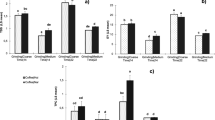Abstract
In this study, the effects of roasting method, grinding and reduction in oil content on the characteristics of Pistacia terebinthus fruit coffee were investigated. Pistacia terebinthus fruit was roasted by microwave, pan and combined (microwave and convection) methods. The degree of roasting was determined by L*, a*, b* color values. The roasting times were 1,500, 1,900 and 1,620 s for microwave, pan and combined roasting methods, respectively. Cold press was used to reduce the oil content both prior to roasting and after the roasting. The oil content was reduced to around 21.5 % in all roasting methods to approach to that of coffee beans. Powdered Pistacia terebinthus fruit coffee brews were compared with each other and Turkish coffee in terms of aroma, flavor, acidity aftertaste, and overall acceptability. Sensorial analysis results showed that coffee brews prepared by pressing after the roasting process were better than those pressing prior to roasting.


Similar content being viewed by others
References
Andriot I, Quere JL, Guichard E (2004) Interactions between coffee melanoidins and flavor compounds: impact of freeze-drying (method and time) and roasting degree of coffee on melanoidins retention capacity. Food Chem 85:289–294
Baytop T (1984) Treatment with plants in Turkey. Istanbul University Publication. No: 3255. Istanbul University press, Istanbul.
Brollo G, Cappucci R, Navarini L (2008) Acidity in coffee: Bridging the gap between chemistry and psychophysics. 22nd International Conference on Coffee Science, Capinas, SP, Brazil, pp 270–280.
Buffo RA, Cardelli-Freire C (2004) Coffee flavour: an overview. Flavour Frag J 19:99–104
Çiftçi H, Özkaya A, Kariptaş E (2009) Determination of fatty acids, vitamins and trace elements in Pistacia terebinthus coffee. J Food Agric Environ 7:72–74
Clarke RJ (1987) Grading, storage, pre-treatments and blending coffee. In: Clarke RJ, Macrae R (eds) Coffee technology. Elsevier Applied Science, Amsterdam, pp 35–58
Czerny M, Mayer F, Grosch W (1999) Sensory study on the character impact odorants of roasted arabica coffee. J Agr Food Chem 47:695–699
Dalgıç L, Sermet OS, Ozkan G (2011) Farklı kavurma sıcaklıklarının menengiç yağ kalite parametreleri üzerine etkisi. Akademik Gıda 9:26–36
Geçgel Ü, Arıcı M (2008) Çıtlık (Pistacia terebinthus L.) çesitlerinin bazı fizikokimyasal özellikleri ile yağ asitleri kompozisyonunun belirlenmesi. Gidadernegi.org, http://www.gidadernegi.org/TR/Genel/dg.ashx?DIL=1&BELGEANAH=1612&DOSYAISIM=240934712.pdf. Accessed 01.09.2013
Ginz M, Bradbury HH (2000) Formation of aliphatic acids by carbohydrate degradation during roasting of coffee. Eur Food Res Technol 211:404–410
Göğüş F, Ozel MZ, Kocak D, Hamilton JF, Lewis AC (2011) Analysis of roasted and unroasted Pistacia terebinthus volatiles using direct thermal desorption-GCxGC–TOF/MS. Food Chem 129:1258–1264
Griffin M, Blauch J (1999) Determination of the relationship between phosphate concentration and perceived acidity in coffee. In: Association for science and information on coffee, Helsinki, pp 118–126
Illy A, Viani R (2005) Espresso coffee: the science of quality, 2nd edn. Elsevier, London
International Coffee Organization (1991) Sensory evaluation of coffee: Technical Unit Quality Series, London, pp 209–243
Jackson R (2011) Look at aftertaste. Stocktongraham, http://www.stocktongraham.com/a-look-at-aftertaste. Accessed 18.09.2013.
Kocak D, Keskin H, Fadıloglu S, Kowalski B, Göğüş F (2011) characterization of terebinth fruit oil and optimization of acidolysis reaction with caprylic and stearic acids. J Am Oil Chem Soc 88:1531–1538
Martin MJ, Pablos F, Gonzales AG (1999) Characterization of arabica and robusta roasted coffee varieties and mixture resolution according to their metal content. Food Chem 66:365–370
Matthaus B, Özcan M (2006) Quantitation of fatty acids, sterols, and tocopherols in turpentine (Pistacia terebinthus Chia) growing wild in Turkey. J Agric Food Chem 54:7667–7671
Mazzafera P (1999) Chemical composition of defective coffee beans. Food Chem 64:365–370
Nebesny E, Budryn G, Kula J, Majda T (2007) The effect of roasting method on headspace composition of robusta coffee bean aroma. Eur Food Res Technol 225:9–19
Özcan M (2004) Characteristics of fruit and oil of terebinth (Pistacia terebinthus L.) growing wild in Turkey. J Sci Food Agr 84:517–552
Pangborn RM (1982) Influence of water composition, extraction procedures and holding time and temperature on quality of coffee beverage. Lebensm-Wiss Technol 15:161–168
Santos EJD, Oliveira ED (2001) Determination of mineral nutrient and toxic elements in Brazilian soluble coffee by ICP-AES. J Food Compos Anal 14:523–531
Sivetz M, Desrosier NW (1979) Coffee technology. Avi Pub, Westport
Somporn C, Kamtuo A, Theerakulpisu P (2011) Effects of roasting degree on radical scavenging activity, phenolics and volatile compounds of arabica coffee beans (Coffea arabica L. cv. Catimor). Int J Food Sci Tech 46:2287–2296
Topçu G, Bilici M, Sarıkürkcü C, Öztürk M (2007) A new flavone from antioxidant extracts of Pistacia terebinthus. Food Chem 103:816–822
Voilley A, Sauvageot F, Simatos D, Wojcik G (1981) Influence of some processing conditions on the quality of coffee brew. J Food Process Pres 5:135–143
Walheim L, Stebbins RL (1981) Western fruit, berries and nuts. HP Books, Tucson
Acknowledgments
The financial support of the department of Food Engineering at the Gaziantep University is gratefully acknowledged.
Author information
Authors and Affiliations
Corresponding author
Rights and permissions
About this article
Cite this article
Secilmis, S.S., Yanık, D.K. & Gogus, F. Processing of a novel powdered herbal coffee (Pistacia Terebinthus L. Fruits Coffee) and its sensorial properties. J Food Sci Technol 52, 4625–4630 (2015). https://doi.org/10.1007/s13197-014-1475-7
Revised:
Accepted:
Published:
Issue Date:
DOI: https://doi.org/10.1007/s13197-014-1475-7




